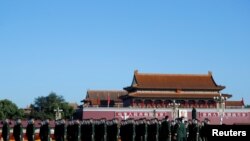On May 25, Chinese Foreign Ministry spokesperson Hua Chunying issued a series of tweets about China’s purported commitment to “non-hegemony, non-expansion and non-coercion.”
Hua said that despite having a “longer boundary, more neighboring countries, and more historical complications than any other country in the world,” China has established “boundaries with 12 of its 14 land neighbors” through “peaceful negotiations.”
She said the People’s Republic of China has been peaceful since its birth in 1949.
“For the last 70-plus years since the founding of the People’s Republic, #China has never started a war or encroached upon a single inch of foreign soil. China is the only country that has codified #peacefuldevelopment in its constitution,” she wrote.
The claim that communist China has “never started a war or encroached upon a single inch of foreign soil” is false. Beijing initiated several wars and/or conflicts with neighbors, at times occupying their territory.
While Beijing maintains it never “encroached on foreign soil,” citing mere territorial disputes, that does not apply to the Sino-Vietnamese War and subsequent invasion of Vietnam.
On February 17, 1979, hundreds of thousands of Chinese troops crossed the border into Vietnam.
The move was a response to Vietnam’s invasion of Cambodia in December 1978 to depose Pol Pot, whose communist Khmer Rouge government presided over the deaths of some 1.7 million Cambodians “through execution, exhaustion and starvation” during its four-year reign.
Vietnam invaded Cambodia after Khmer Rouge forces crossed into Vietnam to reclaim territory. The invading Khmer Rouge committed atrocities, including the Ba Chúc massacre, which saw Cambodian forces kill 3,157 Vietnamese villagers.
Beijing was allied with the Khmer Rouge regime, but China had no claim to self-defense in moving against Vietnam. Rather, its reasoning appears to have been “hegemonic” based on China’s then-Vice Premier, Deng Xiaoping. He signaled plans to attack Vietnam during a January 1979 visit to the United States, calling Vietnam a “naughty child” which needed to be “spanked.”
The Sino-Vietnamese War lasted just under a month, with China withdrawing its forces on March 16, 1979. Each side claimed it lost thousands of troops, and Vietnam claims tens of thousands of its civilians were killed.
Fighting continued sporadically until 1991, with Chinese forces occupying Vietnamese territory and both sides claiming thousands more deaths.
In 1974, China’s military seized control of Vietnam’s portion of the Paracel Island chain in the South China Sea. China accused Vietnam of occupying the Spratly Islands, another South China Sea archipelago disputed by Brunei, China, Malaysia, the Philippines, Taiwan and Vietnam, and used that as a pretext to invade Vietnam in 1979.
In 1988, China captured six other Spratly Island reefs from Vietnam.
As Polygraph.info previously reported, China has established military outposts in the Spratly Islands, where it has deployed anti-ship cruise missiles and long-range surface-to-air missiles.
China has sunk Vietnamese fishing boats near the Paracel Islands and used the threat of force to halt Vietnamese oil drilling projects off Vietnam’s southeastern coast.
China claims “indisputable sovereignty” over most of the South China Sea and its islands. Beijing continues to use or threaten force to maintain control of islands and reefs there, in contravention of international law.
In 1962, three years after China invaded Tibet, Beijing instigated a border war with India.
In "New Directions in the Study of China's Foreign Policy," Robert Ross wrote that there was a consensus among China scholars that the root cause of the 1962 war was China’s belief that India “sought to undermine Chinese rule and seize Tibet.”
China held that view despite the fact that India had actually played a key role in blocking an El Salvador-sponsored appeal to debate China’s invasion of Tibet before the United Nations General Assembly.
The Sino-Indian conflict was precipitated by clashes between Indian and Chinese forces along the two countries’ disputed Himalayan border.
On October 18, 1962, the Chinese Communist Party’s Politburo decided to launch “a self-defensive counterattack war” on October 20. After achieving its military objectives, China declared a unilateral ceasefire the following month and withdrew its troops 20 kilometers from the Line of Actual Control that separates Chinese from Indian territory.
China consolidated control over Aksai Chin — the eastern part of the Kashmir region, which India disputes to this day.
Beijing initiated another war with India in the region in 1967, and border clashes flared up between the two countries last year.
China has openly started building settlements within Bhutan’s internationally recognized border, with Foreign Policy reporting that Beijing is “mirroring in the Himalayas the provocative tactics it has used in the South China Sea.”
According to Foreign Policy, China has created several villages, security outposts and infrastructure projects in a 232-square-mile area identified as Bhutanese territory on official Chinese maps up until the 1980s.
China now claims the land is part of Tibet.












